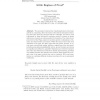Free Online Productivity Tools
i2Speak
i2Symbol
i2OCR
iTex2Img
iWeb2Print
iWeb2Shot
i2Type
iPdf2Split
iPdf2Merge
i2Bopomofo
i2Arabic
i2Style
i2Image
i2PDF
iLatex2Rtf
Sci2ools
LICS
2002
IEEE
2002
IEEE
Little Engines of Proof
The automated construction of mathematical proof is a basic activity in computing. Since the dawn of the field of automated reasoning, there have been two divergent schools of thought. One school, best represented by Alan Robinson’s resolution method, is based on simple uniform proof search procedures guided by heuristics. The other school, pioneered by Hao Wang, argues for problem-specific combinations of decision and semi-decision procedures. While the former school has been dominant in the past, the latter approach has greater promise. In recent years, several high quality inference engines have been developed, including propositional satisfiability solvers, ground decision procedures for equality and arithmetic, quantifier elimination procedures for integers s, and abstraction methods for finitely approximating problems over infinite domains. We describe some of these “little engines of proof” and a few of the ways in which they can be combined. We focus in particular o...
| Added | 15 Jul 2010 |
| Updated | 15 Jul 2010 |
| Type | Conference |
| Year | 2002 |
| Where | LICS |
| Authors | Natarajan Shankar |
Comments (0)

